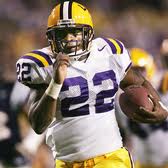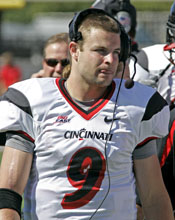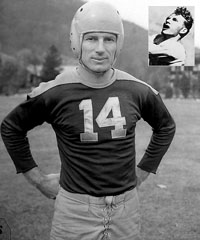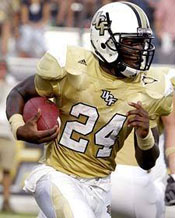CONTENTS
The Forward Pass's Uphill Battle
New NCAA Transfer Rule
Prolific D-II Rusher
Don Hutson's Big Day
Cardinal and Gold for the Maroons
Who's Kevin Smith?
Best OTs in the Land
Monumental Upset
Giants vs. Rough Riders
What Happened to Alley Broussard?
Football:
Did You Know? I
Football: Did You
Know? III
Football: Did You
Know? IV
Football: Did You
Know? V
Football: Did You
Know? VI
Football: Did You
Know? VII
Football Magazine
Golden Rankings Home
Top
of Page |
Football:
Did You Know? – II
The Forward Pass's Uphill Battle

St. Louis back credited in 1906 with throwing
the first forward pass in a college game.
It fell incomplete and thus resulted
in a turnover.
|
Football began as an offshoot of rugby, a game that does not allow the ball to be thrown forward. Coaches in the early decades considered forward passing unmanly and not sporting.
This trace of the rules governing forward passing in college football shows how long a period it took to reach the unlimited aerial game we see today.
- 1906
The forward pass is legalized but with severe restrictions.
- The pass must be thrown by a player who was in the backfield when the ball was snapped.
- Only the players lined up at the end of the line could catch the ball. A pass that hits an ineligible receiver is incomplete.
- An incomplete pass turns the ball over to the defensive team at the point where the ball hit the ground. If the ball goes out of bounds, any player can recover it.
- Any pass must cross the line of scrimmage more than 5y away from where the ball was snapped. Likewise, the receiver must not cross the line of scrimmage within 5y of the centering point. If this rule is violated, the pass is considered incomplete.
Note: Because of this rule, lines 5y apart parallel to the sidelines were added to playing fields. A reporter wrote that the field thus resembled a "gridiron."
- A pass that crosses the other team's goal line is treated as a touchback. The defensive team gains possession on its 20.
|
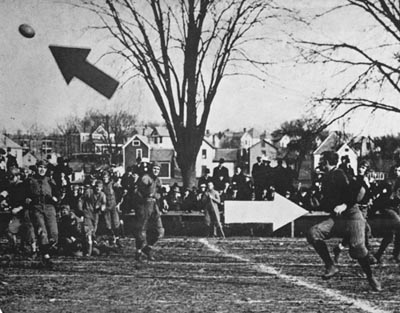
Pete Gilman of Marietta has just released a 52y TD pass against Ohio in 1906.
- 1910
- The rules requiring passes to be thrown and received within 5y of the center point are rescinded.
- Forward passes are limited to 20y in length and must be thrown from at least 5y behind the line of scrimmage.
- 1912
- The 20y limit for passes is removed.
- A pass completed in the opponent's end zone is a TD, not a turnover.
- An incomplete pass results in a loss of a down, not a turnover.
- 1926
- The second (or third or fourth) incomplete pass in a row carries a penalty of 5y.
- An incomplete pass in the opponent's end zone is again considered a turnover.
- 1934
- The 1926 penalties against incomplete passes are eliminated except that two successive incomplete passes in the end zone produce a touchback. Likewise, a 4th down incomplete pass in the end zone is a touchback.
- 1938
- Except for fourth down passes, incompletions in the end zone are not treated as touchbacks but simply loss of down.
- 1941
- A fourth down pass incomplete in the end zone gives the opponent the ball at the spot where it was put into play.
- 1945
- The requirement that passes must be thrown from at least 5y behind the line of scrimmage is eliminated.
- 1949
- Offensive linemen may not cross the line of scrimmage on a pass play until the pass is completed.
Reference: The Ultimate Guide to College Football, James Quirk (2004)
Top of Page |
|
Cincinnati QB Ben Mauk is a senior in his first year (2007) at the university.
How did this come about?
- Because of the NCAA's new rule allowing a player
who has his degree with a year of eligibility left to transfer to another
school without having to sit out a year.
- Ben was at Wake
Forest for his first three years of eligibility. However, he suffered
a nasty injury in the first game of the 2006 season when he dove for a lose
ball and two Syracuse defenders landed on his right arm, breaking his humerus badly. Surgeons inserted
a plate and eight screws. Three more metal anchors were added later. "I
didn't think he was going to play again," says Jim Grobe,
his coach at Wake.
- After getting his degree last spring, Ben transferred to UC in his home state
without knowing if he could play again. His successful rehab convinced
new coach Brian Kelly to put him in charge of the spread,
no-huddle offense, which has propelled the Bearcats to their
best season in many years.
|
|
Danny
Woodhead is a senior TB at undefeated Chadron State,
a Division II school (Fall 2007).
- On
October 6, 2007, the 5'7" 200 pounder became the most prolific
rusher in college football history, breaking the NCAA record of 7,353
yards set in 2000 by R.J. Bowers of Division III
Grove City (Pa.) College. No active rusher is within 1,855 yards of
Woodhead.
- He
set rushing records at North Platte HS in Nebraska, where his father
was an assistant coach.
- He
was timed at 4.43 seconds for the 40-yard dash and his vertical jump
is more than 33 inches. 16 of his rushing TDs have come on runs of
more than 60 yards. As of the November 10 games, Danny
has 1,318 yards for 2007 with 18 TDs, the longest being 89 yards.
That averages out to 146.4 ypg.
-
"There's
no doubt in my mind that he's a Division I talent," says his coach, Bill O'Boyle. "Can he play in the NFL? Without
question," says Don Beebe, another Chadron
State player who made it in the NFL and after whom the school's
stadium is named. "If you're that good, they'll find you."
-
Even though Danny was named Nebraska high school player of the year
for 2003, Division I schools showed little interest because of his size
(180 lbs then). Nebraska,
where he always yearned to play, told him he could walk on as a kick returner.
His only scholarship offer was from Chadron.
|
|
|
|
On
October 7, 1945, the Green Bay Packers hosted the Detroit Lions in Milwaukee. Don
Hutson scored four touchdowns and kicked five extra points
for a total of 29 points in the 57-21 Packer victory.
- The TDs all came on pass receptions from Irv Comp and Don McKay.
- Hutson ended his 11-season
career that year. During that time, he led the NFL in receptions eight
times, in scoring five times, and in interceptions once. (He was an
outstanding safety in those days of one-platoon football.)
- He totaled
99 TD passes, a record that was not broken until 1989 by Steve
Largent. At the time of his retirement, he held a total of
18 records.
Hutson's name is also connected to the
player on the opposite end from him at Alabama: Paul "Bear" Bryant. Hutson actually came to the Crimson Tide on a baseball scholarship.
|
|
Cardinal and Gold for the Maroons
Only
once has a Mississippi State team appeared in any other
color combination than maroon and white.
- In 1938 first-year football
coach Spike Nelson secretly had cardinal and gold uniforms
made for State. However, this choice did not sit well
with the team or the fans at the first game. Neither the uniforms nor Nelson were back for the next season.
- The year started
prominently with three straight shutouts over Samford, Florida, and Louisiana Tech. After a loss to Auburn in Montgomery, the Bulldogs defeated Duquesne in Pittsburgh 12-7. Then a two-game Louisiana sojourn produced defeats
at Tulane (0-27) and LSU (7-32). The season concluded with three
more losses to Centenary in Meridian, at Southwestern,
and to archrival Ole Miss in Starkville 6-19.
|
|
Central
Florida's Kevin Smith was a RB at Miami
Southridge High until he was moved to safety his senior year. This caused
several BCS colleges to drop him from their recruiting lists. Rivals.com,
the premiere recruiting site, assigned him only two stars (out of five).
The Knights recruited
him as an RB, and he is now the leading rusher in the history of the
state of Florida (take that, Gators, Seminoles, and Hurricanes!). Kevin needs 180
yards in the Liberty Bowl to break Barry Sanders' single-season
rushing mark. He has decided to return for his senior season to add
to his records.
Contrast
two-star Smith with the #3 RB on Rivals' 2005 list, Jason Gwaltney from Long Island NY who received five
stars – although the fifth star came only after Jason himself anonymously politicked for it on various message boards.
Rivals also designated Gwaltney "the #1 impact
freshman" for the upcoming (2005) season. Jason signed with West Virginia after toying with USC.
However, Jason battled injuries and watched as another
freshman RB, Steve Slaton from PA, emerged as UWV's
main man despite earning only three stars from Rivals. Unhappy in Morgantown, Gwaltney started talking about transferring almost
as soon as he arrived. He returned home at the end of the season and
played for Nassau Community College in 2006. He didn't play for anyone
in 2007.
|
|
|
Ohio
State's starting OTs, senior tri-captain Kirk Barton
and junior Alex Boone, will be under the microscope
in the BCS Championship Game against LSU.
Reason? What is widely considered their woeful performance in last season's
championship game against Florida's
quick DEs. Yet some now call them the "finest pair of tackles in
the nation." (One of those proclaiming OSU's O-line
the best in the nation is ESPN's Lee Corso, who after
the 2006 OSU-UM game gushed, "These are clearly the two best teams in the nation!")
Barton
didn't even make his all-county team in high school but is now a two-time
All-Big Ten selection and a member of some All-America teams. He is
one of only three players in OSU history to start and
win four times against archrival Michigan.
He has been in and out of Jim Tressel's doghouse, first
for popping off to the media after a game about why soph QB Troy
Smith wasn't starting and again for appearing for an interview
after the '06 win over UM
with a lit cigar and a bottle of champagne. At a recent press conference,
Tressel was asked how much he'll miss Barton next season. "A year ago, I'd have said, 'Very little.'" For
the stoic Buckeye coach, that was high humor and brought
a laugh from the reporters.
"J.
J." Boone is much more intense than the happy-go-lucky
Barton. His problem has been alcoholism. As a freshman,
he often downed 30-40 beers a day. The 6'8" Boone
has his weight down to 315 this season from a high of 350. Since the
Buckeye staff believes the team got soft and stale
during the 51-day layoff after the 2006 season, they have worked the
team harder in practice and in the weight room. So Boone
may weigh less than 315 at kickoff unless he overeats New Orleans' rich
cuisine during the five days the Buckeyes are in town
(another change by Tressel – last year they arrived
in Arizona 10 days ahead).
Keep
an eye on the edges when OSU has the ball. Who wins
the perimeter battles may well determine the victor.
Reference:
"Second Chance", Sports Illustrated, Austin
Murphy 12/31/07 |
|
The
Wall Street Journal: "When ULM
beat Alabama by seven
points in November [2007], it was nothing short of a fiscal miracle."
Louisiana-Monroe's total
football expenses last season were $2.6 million. That's $19 million
less than Alabama's.
But the disparity is even greater when you look at the coaches' salaries.
Nick Saban earns $4 million a year –
the highest salary in college football. ULM's
coach, Charlie Weatherbie, earns $130,000, which is
one of the lowest salaries. So Saban earns more in
two weeks than Weatherbie makes in a year.
Reference:
Wall Street Journal, 12/21/07 |
On
August 12, 1950, the New York Giants played a preseason
exhibition game in Ottawa, Canada, against the Ottawa
Rough Riders. The Canadian Football League had not yet
been formed (1958 was the CFL's maiden season). So Ottawa
played a game more akin to rugby than to American football.
The
first half was played with Canadian rules.
- 12 players on
a side
- No blocking ten yards beyond the line of scrimmage
- Only
three downs to make ten yards for a first down.
- Also, the field was
110 yards long with 25-yard end zones.
- Any kick into the end zone (except
a made FG) that was not returned past the goal line gave the kicking
team a point, a score called a "rouge."
- TDs counted for only
five points. The goal posts were on the goal line but in 1950 that was
true in the NFL as well.
The second half followed American rules, with
makeshift lines shortening and narrowing the field.
15,000
fans at Lansdowne Park saw the Giants, coached by Steve
Owen, take a 13-6 halftime lead despite adjusting to foreign
rules.
- The Rough Riders scored
first on a pass for a 5-0 lead. (The conversion failed.) Then the Giants' Tom Landry (future Hall of Fame coach for the Cowboys)
punted into the end zone for a rouge.
- After a fumble recovery, Landry completed three straight passes to set up a 7y TD run by Steve
Hattfield. Ray Poole kicked the PAT for an
8-5 lead.
- A 60y TD run for the Giants was called
back because of an illegal block past the ten-yard limit.
- The visitors
were also penalized 15 yards for "high tackling," an accepted
NFL custom outlawed in Canada.
- The only other Ottawa score in the first half was a rouge. However, NY mounted
a drive led by backup QB Allie Sherman, who doubled
as the backfield coach (and who would coach in Canada in 1953 before
rejoining the Giant staff in 1959).
- Sherman used the classic three HB "T" formation against Ottawa's
eight-man front to spring RB Bob Griffith loose on
several long runs before Sherman passed to E Bill
Swiacki to set up Hattfield's 3y TD plunge.
Playing
by their familiar rules in
the second half, the bigger, stronger Giants pulled
away.
- First string QB Charley Conerly's passes set
up two six-point TDs by Griffin on one- and two-yard
plunges.
- The final score was 27-6.
The
1950 Giants finished 10-2 and tied for first place
in the American Conference of the NFL. However, they lost a playoff,
8-3, to the Cleveland Browns,
who joined the league that season after dominating the defunct All-American
League. The Browns then
won the championship over the Los Angeles Rams, winners
of the National Conference in a playoff over the Bears,
30-28. Meanwhile, up north, the Rough
Riders finished 5-7 for third place in the Eastern Division
of the Inter provincial Rugby Union (IRFU).
The Giants and Rough Riders (not to be confused with the Saskatchewan Roughriders) played another pre-season game in Ottawa in 1951. NY won again, 38-6.
Reference:
New York Times, 8/13/1950 |
|
|
What Happened to Alley Broussard?
Alley
Broussard departed the LSU
team as August practice started in 2007. After setting a single-game rushing
record with 250 yards against Ole Miss
in 2004, Broussard missed the 2005 season after suffering
a knee injury during pre-season practice. He played sparingly in 2006 (74
carries for 281 yards), primarily because he was overweight and out of condition
after his rehab.
Alley
played the 2007 season at Missouri Southern
State, a Division II school in the Mid-America Intercollegiate
Athletics Association. He played in ten games, rushing for 892 yards on 165
attempts for a 5.4 average-per-carry and 89.2 yards-per-game. He was the team's
leading rusher by over 100 yards. The team finished with a 6-5 record.
Watch YouTube
video to remind you how good Alley was before his injury.
|
|
